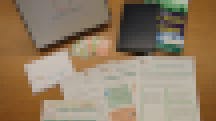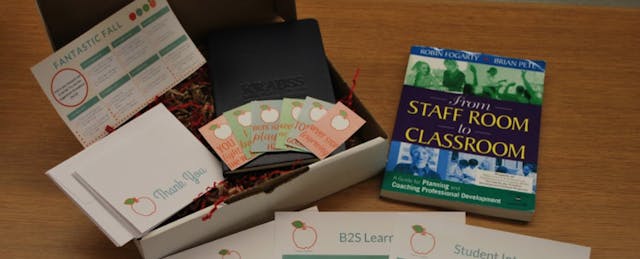As I sat at a giant table with 15 colleagues pondering how to make professional learning more personal for our teachers, my eyes drifted to my screen. That’s when it dawned on me.
My supervisor glanced up at me, wondering what I was looking at on my computer. I spun around my laptop, which was currently displaying Mancrates, a website that sends Valentine’s boxes to avid lovers of artisanal meats.
I quickly clicked through some other tabs that were populated with images of boxes filled with ingredients for cooking, cosmetics, clothing and more. There was something for everyone. “What if we could apply the subscription box model to professional learning?” I asked the team.
As the digital learning, innovation, and design resource teacher for Howard County Public Schools in Maryland, I serve several functions, one of which is to provide professional learning directly to school-based staff.
Our weekly after school workshops had seen low attendance for months and our district had recently experienced significant budget cuts, which meant fewer opportunities to meet with teachers in person and a decrease in resources from the previous school year. We knew we needed a change.
I had recently been asked to seek an innovative, cost-conscious way to make professional learning more personal for educators. Around the office, in schools and online, I saw people excited to receive their StitchFix, FabFitFun or Blue Apron boxes and posting what they learned from these subscriptions and why they loved them.
In an effort to keep our professional learning low-budget, and to bring some happiness to teachers’ lives, I started drafting an idea of how to apply these same ideas to our work and recruited another resource teacher, Carrie Trudden, from the instructional technology office, to help me make the idea a reality. We decided to call it “Happy Apples: Out of the Box Professional Learning.”
Unboxing PD
After researching companies with different types of subscription boxes, we decided we wanted to include an element of surprise, make it gift-like, offer individualized products and make sure it’s useful. Most importantly though, we wanted each box to improve teaching and learning and to develop empowered learners.
We used the design thinking process to build a prototype, imagining an individual teacher as our audience. Once we had our first box, we brought it to a larger team of colleagues for feedback. Once our idea seemed realistic enough to produce within our budget and human capital constraints, we choose to pilot the project at one elementary and one middle school where we already had strong support for professional learning from school leadership and teacher leaders.
In early August before staff returned from summer break, we asked the school leaders at a select number of schools to recommend five to ten staff members who might be interested in trying out this new model. For our first round, sixteen staff members including teachers, reading specialists, media specialists and para-professional educators signed up by completing a short interest survey.

After completing the survey, each participant provided some basic information such as what grade level and content area they taught, and selected topics of interest from a short list of 10 that included instructional technology, building student relationships, family involvement and leadership development. Once we had each individual’s information, we began curating and collecting articles, Twitter accounts, podcasts and books that would fit each member’s profile.
We also developed some original personalized materials including compliment cards for teachers to give to students, thank you cards to give to colleagues, and a fall checklist of activities to encourage subscribers to try out the resources inside their box. Finally, we created student activities that matched each subscriber’s content and grade level and complimented the other professional learning materials in the box.
We delivered our first Happy Apples Boxes in September 2017 to 16 teachers at the two schools. We hand-delivered the boxes in the middle of the day without notifying the teachers, leaving them in each teacher’s school mailbox.
Each box was packed with red tissue paper so it would feel like opening a gift. Inside, we included a welcome letter, an activity checklist and a one page document we called “Learning Bytes” with digital resources, articles and social media accounts to follow. Teachers also received an instructional activity and digital tool to try, along with something specific they could introduce to their students. We rounded the boxes out with other goodies: a set of thank you cards for colleagues, a self-reflection journal and a second-hand book we thought they might enjoy.
One thing we know is that feedback matters, so after we delivered two boxes to our small pilot group, we met with the teachers to discuss the boxes and gauge their reactions. The teachers loved the surprise of finding the boxes in their mailboxes, having professional learning materials tailored just for them and having instructional resources that were quick and easy to use. They suggested more in-person opportunities to share with others who received boxes and a easier way to provide feedback.
The pilot has been a big success, and we will deliver a total of five boxes to our pilot group of teachers throughout this school year. Our next step is to figure out how we can scale the model to reach more teachers.
There are two challenges to scaling: human capital and budget for materials. My colleague and I created many of the resources from scratch, creating them them for each teacher. Developing the profiles, creating the resources and tailoring them takes time, but we’ve found that reallotting our time from planning after school professional learning workshops to working on Happy Apples is doable.
The monetary cost of producing the boxes has been minimal so far. We purchased the cardboard boxes with office funds, use our Canva account to design the printable resources, and use our district’s print shop for printing our materials. The books we share are all second-hand and the journals, pens and extras are all donated by community organizations. This model has its limits if those resources dry up and we’re currently exploring ways to sustain these. We think community partnerships will be key.
Our office is planning to grow our subscribers base to 60 staff members from fall 2018. As our list of subscribers grow, we will need to recruit additional team members to build teacher profiles, design and curate digital resources to meet each subscribers needs and deliver the physical boxes.
We expect that we’ll need to adjust certain elements of the model as our list grows over the next year. Whatever changes we make and however we grow, we’re so excited to see the happiness and renewed energy for learning that this new approach has brought our teachers.


